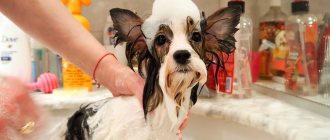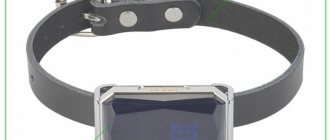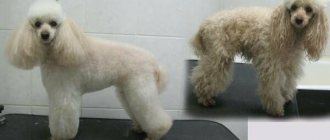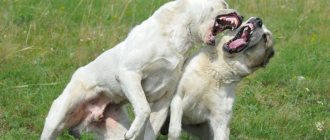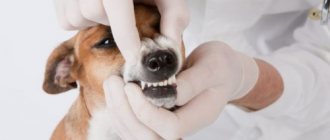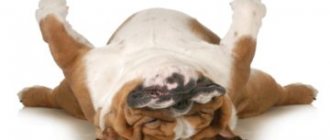Composition and release form
The zoohygienic product is a whitish astringent liquid with a pleasant aroma. Previously it was packaged in 100 ml bottles, but recently more economical forms of release have appeared - 200-250 ml bottles. All packages are equipped with flip-top caps, which makes it easy to squeeze out shampoo in the right amount.
The manufacturer produces three types of shampoo:
- the usual "Doctor";
- with birch tar;
- with climbazole.
The products differ in composition and action.
Regular "Doctor"
The main component of the hygiene product is benzoyl peroxide or benzoyl peroxide. When it comes into contact with the skin, the substance breaks down into hydrogen peroxide and benzoic acid. It acts as a good antiseptic and has the following effect:
- destroys bacteria;
- negatively affects fungi and viruses, in particular staphylococci;
- neutralizes fatty acids;
- normalizes lipid production.
Excipients are:
- purified softened water;
- sodium lauryl sulfate;
- sodium chloride;
- propylene glycol;
- coconut oil fatty acid diethalonamide;
- cocamidopropyl betaine;
- preservative
They moisturize the skin or enhance the effect of the main component, but it is recommended to use shampoo if there are skin problems, such as irritation, or occasionally to prevent their occurrence. If used frequently, it will dry out the skin, leading to severe flaking.
With birch tar
The main chemical composition of the excipients in the shampoo is practically no different from the usual “Doctor”, but its main component is birch tar. It has the following effect:
- improves blood circulation;
- stimulates regeneration processes;
- moderately affects receptors of nerve endings.
Due to the presence of glycerin, the product moisturizes the animal’s skin well and can be regularly used for hygiene procedures.
With climbazole
Features an innovative formula. It is based on two components that have a strong antifungal effect:
- Climbazole is a fungicide whose action is directed against fungi, including the Candida type. The substance suppresses their development and reproduction, thereby ensuring the correct biocenosis of the skin.
- Willow bark extract is a plant component that has anti-inflammatory, antifungal, and antiseptic effects. The composition contains salicylic acid, which stimulates the sebaceous glands, thereby reducing excessive sebum production.
It is recommended to use it to prevent infection with fungal infections, especially during periods of weakened immunity of the animal, for example, when taking antibacterial drugs or infectious diseases.
Fungus in dogs and its development periods
Fungus on a dog's paws usually develops in the spring and autumn, when the weather is slushy and damp. In some areas of the country, where there are damp, rainy summers or warm, snowless winters, mycosis on the paws is diagnosed in animals all year round. The dog licks and chews its paws, limps or pulls up its paws. Externally, the owner may find that:
- claws peel off, change their color and/or structure,
- the pads peel, bleed, are covered with cracks or wounds,
- the fingers are red, swollen, left without hair, the interdigital space is red, the skin in it is exfoliating, peeling off.
Any of these signs is a reason for an urgent visit to the veterinarian. An advanced form of mycosis on the paws leads to loss of hair, changes in the dog’s gait due to constant lameness, and the animal gnawing and licking itchy places. When a dog constantly licks or chews a fungus-infected paw, harmful microorganisms enter his digestive tract and can begin to multiply there. Thus, the external disease becomes internal and is much more difficult to treat. In addition, self-bites and scratches on the paws can begin to become inflamed, infected, and fester. Then the fungal infection will be complicated by an abscess and even sepsis.
Fungus on an animal's tail
Mycosis of the tail in a dog is usually not limited to one area and spreads to the skin of other parts of the body - most often to the back and sides. If a dog combs its tail excessively, chews or licks it, it runs the risk of introducing pathogenic fungi into its mouth, digestive tract, and also into the genitals if, after licking the tail, it licks the prepuce or genital slit. This is especially dangerous for pregnant bitches due to the risk of infection of fetuses, young puppies and very old animals with chronic diseases or weakened immune systems. Mycosis lesions on the tail are a type of skin fungus.
Skin fungus in dogs is the most common reason for owners to contact a veterinary dermatologist. The disease is often contagious and caused by fungal organisms - normal, opportunistic and pathogenic. Often accompanied by a bacterial or viral infection.
Mycosis on the ears
Ear fungus in dogs is not a contagious disease and develops against the background of a general weakening of the immune system with the participation of fungi of the genus Candida and Malassezia, which are characteristic of the dog’s skin. These are yeast fungi that are constantly present in the ears and other parts of the body of animals. Under favorable conditions, yeast fungi begin to actively multiply and change the myco- and microflora in the external auditory canals.
The impetus for the pathological growth of a fungal colony is most often a bacterial infection. Fungal organisms perceive bacteria as a threat and begin to fight them. Also, the proliferation of microflora is often caused by ear mites - otodectosis. In this case, it is necessary to treat both bacterial, tick-borne, and fungal infections.
Exudate forms in the ear canal, which dries out, forms crusts and clogs the passage. The dog hears worse, becomes more nervous and even aggressive. If the nerves are affected, the dog will also experience nervous seizures, reminiscent of rabies or epilepsy.
Failure to adequately treat ear fungus can lead to impairment and even loss of hearing in your dog. In addition, constant scratching of the ears is complicated by infection with bacteria and viruses, as a result, inflammatory and purulent-inflammatory processes of the ear canal, eardrum, and external auricle.
Ear fungus in dogs has the following symptoms:
- the dog shakes its head violently, as if trying to shake out droplets of water or a foreign body from the ear canal,
- the animal scratches its ears and head with its paws or rubs its head on objects,
- the ears have acquired a reddish color, a vascular network has appeared on the auricle (not always),
- On the ears there are signs of alopecia - pathological loss of hair and the appearance of short thickened or, on the contrary, thinning hairs in places of bald patches.
If you notice something like this in your pet, the owner should take him to a veterinarian for tests and scrapings. Confirmation of mycosis requires urgent initiation of treatment. However, even if the dog’s ears are affected not by a fungus, but by another infection, they still need treatment due to the risk of complications or the development of dermatomycosis.
Purpose and action
Shampoo "Doctor" is intended for hygienic care of animals with problem skin. Can be used for therapeutic or preventive purposes for the appearance of skin diseases - dermatitis, acne, rashes.
The skin acts as a protective barrier for the body, but under the influence of certain factors, for example, a weakened immune system, it may not cope with its functions. In this case, redness, inflammation, and allergic reactions appear. The shampoo helps maintain skin biocenosis and provides protection against fungal and other infections.
It has the following effect:
- stops inflammatory processes;
- enhances the effect of antiparasitic drugs;
- prevents the development and proliferation of fungal infections;
- normalizes the functioning of the sebaceous glands;
- eliminates unpleasant odors;
- relieves itching;
- stimulates skin restoration.
It perfectly washes even long animal hair and removes damaged or exfoliated epithelial cells, accelerating regeneration processes.
Treatment of mycoses in dogs
How to treat fungus in a dog can only be decided by a veterinarian after a thorough examination of the four-legged patient. Some types of fungal organisms glow green when irradiated with an ultraviolet lamp. To diagnose other types, the doctor takes scrapings from the location of the fungi and does a culture in the laboratory.
Only after a diagnosis of mycosis has been made and the causative agent has been accurately identified, medications are prescribed. You cannot use anything to treat your pet for a fungus on your own, on the recommendation of a neighbor, or because this remedy helped last time, since what is effective against one type of microorganisms does not work at all against another type.
Antifungal medications for dogs are available in various dosage forms:
- Shampoos with antimycotic components - nizoral, clotrimazole, ketoconazole. These shampoos have a therapeutic effect, but they can also be used to prevent mycoses. In particular, such a shampoo is simply necessary after a dog has come into contact with an infected animal, after swimming in an open body of water, especially in one where the water “blooms”, after wallowing in a puddle or the excrement of other animals, as well as after hunting a fox, badger, etc. with which the hunting dog entered the fight. Wild animals are potential sources of fungal and other infections.
- Antifungal vaccines - Vakderm, Polivak, Microderm. They are used for the prevention of mycoses, as well as for the treatment of already diagnosed diseases. Vaccination is carried out in two stages with an interval of two weeks. It is necessary to take into account the breed characteristics of the pet, because some hunting breeds develop allergies to antifungal vaccines and even develop an abscess at the injection site.
- Antifungal sprays - zoomicol, fungil, which are sprayed on the affected areas or even on the entire surface of the animal’s body. Sprays penetrate well even through long and thick fur.
- Ointments with components against fungal microorganisms. They are applied to the lesion, slightly extending beyond its area. If necessary, apply a loose bandage. For a better therapeutic effect, it is worth cutting or shaving the hair from the treated area.
- Birch tar, a previously known folk remedy, gives a good effect. This is a very unpleasant and strong-smelling liquid. Tar is completely unsuitable for cats due to the risk of developing a severe allergic reaction. But it is safe for dogs and helps them well, relieving itching, eliminating all pathogens and drying out bite wounds and scratches.
Sometimes dog fungus spreads so much throughout the dog's body that the affected areas are difficult to treat. A long-haired dog should be cut as short as possible if he does not live outside in the winter or does not participate in exhibitions. As a last resort, long hair should be thoroughly combed with a brush and comb, untangled and matted hair removed. If possible, you should use a furminator to remove the faded undercoat. If weather conditions allow it and a long-haired dog does not need to perform at an exhibition, then it is worth profiling, in other words, thinning out the thick coat.
To prevent self-biting and licking of lesions, as well as licking of medicinal ointments, it is advisable to wear a protective collar on the animal. Such collars are sold in veterinary clinics and pharmacies, in pet stores, and are selected according to the volume of the dog’s neck and the length of the dog’s muzzle.
Causes and prevention of fungal diseases in dogs
Fungal microorganisms exist in absolutely all biological niches: in salty and fresh water bodies, on any type of soil, on any substrate, including living organisms, in dry and wet, in acidic and alkaline environments. Therefore, it is not at all easy to fight them. Fungi are very tenacious and are capable of completely restoring their colony in a short time, like Leishmania.
The reasons for contracting a fungal infection are numerous: contact with an infected animal, contact with the excrement of a sick dog, swimming in a body of water with stagnant and “blooming” water.
One of the main conditions for the treatment and prevention of mycoses in dogs is to clean the room where the dog lives, the enclosure, and the bedding from sources of infection. It is necessary to thoroughly treat all surfaces with cold water and dissolved chloramine. The floor, walls, and furniture sets need to be treated. It is better to entrust upholstered furniture on which a dog can lie, carpets and rugs to a professional pest control service. But it is also possible to clean them yourself with a solution of chlordesine.
Toys, cages, bowls and other animal accessories must be treated with formaldehyde and thoroughly rinsed to remove any traces of the substance. Bedding, soft toys, fabric collars, leashes and harnesses should ideally be replaced with new ones. But as a last resort, they can be soaked in very hot water with baking soda dissolved in it, and then rinsed.
If the animal is kept in the yard, then the enclosure and kennel should be treated with a disinfectant solution, the bedding and the top layer of sand or crushed stone flooring in the enclosure should be replaced. For preventative purposes, bedding and bulk coverings in the yard must be regularly changed or cleaned of dirt and disinfected. It is necessary to wash outdoor shoes daily and put them out of reach of the dog so that the pet does not play with them.
FOR VETERINARY
Antifungal shampoo with propolis for animals is intended for hygienic care of the skin and coat of animals, prevention and treatment of skin diseases of various etiologies.
It has antiseptic, antifungal, antibacterial, antipruritic and deodorizing effects.
Effect
: visible improvement of the skin and improvement in the quality of the animal’s coat.
COMPOSITION (1ml):
Ketoconazole - 20 mg, piroctone olamine 5 mg, propolis extract - 0.5 mg and auxiliary components: cocamidopropyl betaine, cocamide DEA, sodium laureth sulfate, D-panthenol, St. John's wort extract, nettle extract, chamomile extract, citric acid, methylchloroisothiazolinone and methylisothiazolinone, fragrance, purified water.
INDICATIONS:
For hygienic care of the skin and coat of animals (deep cleansing and moisturizing of the skin, nutrition and strengthening of the coat);
For the prevention and treatment of dermatomycosis (seborrhea, microsporia, trichophytosis and others);
To normalize the functioning of the sebaceous glands;
For the rehabilitation of wounds, abrasions and cracks;
The shampoo is used for animals from 3 weeks of age.
MODE OF APPLICATION:
Before starting treatment, carefully comb the animal's fur with a comb, freeing the affected areas of the skin from crusts and dandruff. Shampoo is applied to the wool moistened with warm water, evenly distributed over the entire surface of the body, rubbing in with massaging movements until abundant foam is formed, avoiding contact with mucous membranes and preventing the animal from licking the foam. After 5-10 minutes, rinse the shampoo thoroughly with warm water, dry the coat and comb it. If necessary, repeat the procedure. Depending on the skin pathology, to achieve an optimal therapeutic effect, treatment of the animal must be repeated every 5-7 days until clinical recovery.
To prevent skin diseases, 1-2 treatments per month are sufficient.
CONTRAINDICATIONS:
Individual hypersensitivity to the components of the drug.
STORAGE CONDITIONS:
Store in sealed manufacturer's packaging in a dry place, protected from direct sunlight, away from food and feed, at a temperature of 0° to + 25° C. Shelf life, subject to storage conditions, is 36 months from the date of production. Do not use after expiration date.
Keep out of the reach of children!
AVAILABLE WITHOUT A VETERINARY PRESCRIPTION.
RELEASE FORM:
Polymer bottle with a volume of 250 ml. The bottle is sealed with screw caps with or without a dispenser and packaged in cardboard boxes.
Russia, 107139, Moscow, Orlikov per. d.3.
Skin is an important and largest organ in a dog, the main function of which is as a barrier. Violation of the integrity of the skin causes negative consequences for the pet, so you need to carefully monitor its condition and take timely measures. One common problem is fungus.
Indications for use
Recommended for animals with problem skin. Indications for use may include:
- dermatitis;
- rashes;
- seborrhea;
- infestations by ticks, fleas or other parasites;
- inflammatory processes;
- acne;
- folliculitis;
- fungal or bacterial infection.
Regular “Doctor” has a drying effect and promotes exfoliation of the epithelium, therefore it is suitable only for medicinal purposes. Cannot be used continuously as a hygiene product. Shampoo containing birch tar has a different effect on the skin (moisturizes it) and can be used for daily or regular use over a long period.
It is recommended to use shampoo with any composition before treating the animal with antiparasitic agents.
How to wash your dog with medicated shampoo
As a rule, it is recommended to leave medicated shampoos for a few minutes after lathering. Therefore, in winter, you need to be careful when washing your dog so that it does not catch a cold.
During the cold season, a dog of any size will have to be washed at home in the bathroom. A rubber mat should be placed at the bottom of the bathtub to prevent your pet's paws from slipping, otherwise there is a chance that the dog could get injured trying to get out. The water should be at comfortable room temperature. First, the entire coat of the dog must be thoroughly moistened by massaging. It is necessary that the coat is wet right up to the skin, because if you simply water it from above from the shower, the undercoat may remain dry.
Then shampoo is applied evenly over the entire coat, rubbing and massaging. The dog is left in the bathroom for the time specified in the instructions. Then thoroughly rinse off all the shampoo. Afterwards, the dog is dried with a towel and left to dry in a warm room. Small dogs can be dried using a hair dryer on a low setting.
How to use
Doctor shampoo is easy to use. You need to follow simple steps:
- Apply a small amount of liquid to the animal's damp fur. The amount of hygiene product directly depends on the size of the pet.
- Lather and then rinse immediately with clean water.
- Reapply and leave on for 5-7 minutes.
- After this, rinse well.
It should be used daily or at intervals of 1-3 days, depending on the composition and functioning of the sebaceous glands, the animal’s lifestyle (consider how quickly the dog’s fur becomes dirty, how much time it spends outside, and so on).
It should be used for treatment for 7-10 days or until the symptoms of the skin disease disappear. As a preventive measure, it is recommended to use antiparasitic drugs several hours before treatment.
Use of local remedies for treatment
When using products to directly treat affected areas, it is important to observe two points:
- ointments and creams are applied from the outer edge of the bald area to the center,
- To prevent your dog from licking off medications, you should wear a protective collar for your pet during treatment.
Such agents are most often used for local treatment.
Ointment for deprivation "YAM BK"The ointment is suitable for the treatment of ringworm, as well as eczema in dogs. Bald areas without prior treatment or haircut are lubricated with a thin layer of ointment 1-2 times a day. The cost of a jar is from 30 rubles. |
Human antifungal shampoos (Nizoral, Mycozoral, etc.)Human shampoos must be diluted in regular water (10 times) before washing the dog. The pet is washed with medicated shampoos once every 3 days, leaving the shampoo on for 5-10 minutes after soaping. The cost of shampoos ranges from 300 to 600 rubles, depending on the company and the volume of the bottle. |
Cream "Sanoderm"The cream is applied in a thin layer to the infected, clipped areas of the skin 2 times a day. After improvements occur, treatment once a day is sufficient. The ointment costs 110 rubles. |
Spray for deprivation "Fungin"The drug is sprayed directly onto the affected areas or applied to a cotton pad and wiped over the skin and nearby fur. Treat once a day. The price of the bottle is 300 rubles. |
Side effects and contraindications
Absolutely safe for dogs. This is confirmed by reviews from pet owners. It can be used for animals of any age, weight, breed. The only contraindication for use is individual intolerance to the components.
No serious side effects were detected during use. In some cases, with prolonged use, the following may occur:
- whitening effect (does not harm the pet’s health);
- increased peeling - it is recommended to stop using. Peeling usually goes away on its own and does not require treatment.
Avoid contact with eyes, as the components irritate the mucous membranes. If this happens, it is necessary to immediately rinse with plenty of running water.
Price
You can now see the current price of shampoo and buy it right here:
The reasonable cost of Doctor shampoo for dogs is one of its main advantages. The price depends on the volume and composition:
- a regular shampoo bottle with a volume of 100 ml costs 150-170 rubles, 200-250 ml – 250-260 rubles;
- product with birch tar 100 ml can be bought for 180-190 rubles, 200-250 ml - 260-280 rubles;
- Shampoo with climbazole 100 ml will cost 200-230 rubles, 200-250 ml - 270-300 rubles.
Different Types of Ketoconazole
Ketoconazole is an antifungal drug , also known as an antifungal drug. Because it is found in several different medications, the dose of ketoconazole in any given formula will vary. Often sold under the brand name nizoral . Although your veterinarian will prescribe this medication under a variety of circumstances, it can also be purchased without a prescription. Although its availability may make it seem like it can be used freely, ketoconazole has various interactions and can be dangerous if used incorrectly.
The type of ketoconazole your veterinarian will prescribe depends on its use. However, in humans, ketoconazole tablets or pills are currently very rare, but may be more common in veterinary medicine. Oral ketoconazole has the advantage of working faster than topical ketoconazole . However, topical products help control the site of certain infections. The most common types of ketoconazole for dogs include:
- Ketoconazole Shampoo Since most dogs are covered in hair/hair, washing with a medicated shampoo can help resolve the fungus problem. It can be used all over the body or only in certain areas, but the instructions must be carefully followed regardless.
- Ketoconazole tablets This antifungal drug can also be found in tablet or pill form. This is a generalized medication that goes into the dog's bloodstream, meaning the dose must be carefully monitored.
- Ketoconazole cream : Topical application of ketoconazole is common and preferred for human use. Due to the dog's fur and tendency to lick, topical cream is not always adequate, but depends on the individual dog...
- Ketoconazole eye drops Since penetration of ketoconazole can be severe, eye drops are not usually used. It is sold under product names such as ketostar, usually in a 0.5% solution, and is used for more serious eye infections. Another treatment for eye infection, such as natamycin, may be more appropriate in milder cases...
Topical medications such as ketoconazole shampoo are not necessarily a treatment for a yeast infection. Instead, they are used to treat symptoms of infection. This reduces the spread of the fungus, but usually requires more systemic antifungal treatment to more directly address the problem. Ketoconazole shampoo may also contain chlorhexidine , which is a germicidal disinfectant.
Regardless of the type or form, ketoconazole is the same active ingredient in these different products. Treatment period In these cases it is usually extended, usually more than two months. For topical use, ketoconazole cream is also similar to shampoo. It mainly reduces the risk of infection and is used in combination with systemic treatment.
Owner reviews
Oksana, owner of the mongrel:
“We have a yard dog, and although he is not purebred, we love him very much, and therefore he spends a lot of time in the house (we live in the private sector). With the onset of heat, the dog began to emit an unpleasant odor, we bought Doctor shampoo to get rid of it. We were very disappointed because the product did not give the desired result. I washed it with difficulty. I don't recommend it."
Julia, owner of a Labrador:
“The dog started to itch a lot. The veterinarian prescribed Doctor shampoo. Used the product once a week. After the first time the dog felt better. The fur became smooth and shiny. Over time, the irritation completely disappeared. I haven’t used any other means or medications, so I can confidently declare their effectiveness.”
Sergey, owner of a 3-year-old dog:
“The veterinarian prescribed it for the treatment of demodicosis. After the first use, the dog developed severe irritation in the form of redness and itching. The doctor said that the pet might have an individual intolerance.”
Where does fungus occur in dogs?
As a rule, the onset of the disease has a certain pattern. At first, the fungus appears on the dog’s paws and ears.
Sometimes it appears only on the interdigital area, on the skin around the claws and on the pads of the paws. The skin becomes rough, inflamed and cracks, crusts or scales appear, the claws turn yellow and begin to bend.
Fungus on dogs' paws most often occurs in the autumn and spring. The pet begins to limp and chew on the affected areas. A fungus can also appear in a dog’s ear, on the inner surface without hair. Since there is sparse hair in these areas, it is easiest to notice the disease there. Ear fungus in dogs is dangerous because if the itching is severe, the pet will actively scratch the area and can damage the ear.


